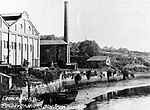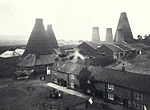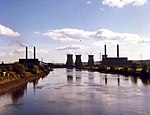Anglo Great Lakes Graphite Plant
1958 establishments in EnglandBuildings and structures in Newcastle upon TyneManufacturing companies of EnglandUse British English from November 2020
The Anglo Great Lakes Graphite Plant was a large graphite works situated in the North East of England. It was positioned at Lemington in Newcastle upon Tyne, on the north bank of the River Tyne. The plant was operated by the Anglo Great Lakes Corporation and produced high grade carbon for use in Magnox nuclear reactors, Advanced Gas-cooled Reactors and low grade carbon for use in carbon arc burning.
Excerpt from the Wikipedia article Anglo Great Lakes Graphite Plant (License: CC BY-SA 3.0, Authors).Anglo Great Lakes Graphite Plant
Goldcrest Way, Newcastle upon Tyne Lemington
Geographical coordinates (GPS) Address Nearby Places Show on map
Geographical coordinates (GPS)
| Latitude | Longitude |
|---|---|
| N 54.969 ° | E -1.712 ° |
Address
Goldcrest Way
Goldcrest Way
NE15 8NX Newcastle upon Tyne, Lemington
England, United Kingdom
Open on Google Maps






